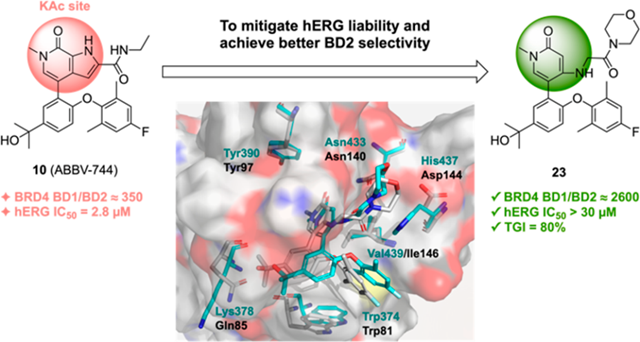Researchers Discover Highly Selective BET BD2 Inhibitors for the Treatment of AML
Recently, the research group led by Prof. Xu Yong at Guangzhou Institutes of Biomedicine and Health, Chinese Academy of Sciences (GIBH, CAS), in collaboration with Prof. Wu Xiaoxing 's group at the China Pharmaceutical University (CPU), reported a series of phenoxyaryl pyridones as highly selective BET BD2 inhibitors for the treatment of acute myeloid leukemia (AML).
Several pan-BET inhibitors have been developed and have advanced into clinical trials. However, the first-generation of pan-BET inhibitors demonstrated dose-limiting toxicities (DLT) such as gastrointestinal toxicity and thrombocytopenia in the clinical trial. Recent studies have indicated that second-generation BD2 selective BET inhibitors offer an improved safety profile compared to pan-BET inhibitors. ABBV-744, a second-generation BD2 highly selective BET inhibitor developed by a pharmaceutical company AbbVie, exhibited both stable efficacy and safety in preclinical in vivo studies. ABBV-744 has entered clinical trials for the treatment of AML and myelofibrosis. However, a patent reveals that ABBV-744 inhibits hERG potassium channels at low micromolar concentrations (hERG IC50 = 3.1 μM), highlighting a potential risk of cardiovascular disease. Therefore, the identification of BET inhibitors with high BD2 selectivity and improved safety is of utmost importance.
In this study, ABBV-744 was utilized as a prototype for employing a ring-opening strategy to reduce planar aromaticity. Through an extensive structure activity relationship (SAR) study, BET inhibitor 23 was discovered, demonstrating higher BD2 selectivity. Compound 23 exhibited robust binding activity to BRD4 BD2 with an IC50 value of 2.9 nM, a BD2 selectivity of 2583-fold, and a significant reduced risk of cardiovascular disease (hERG IC50 > 30 μM). The researchers successfully elucidated the co-crystal structures of the representative compounds with BRD4 BD1/BRD2 BD2, shedding light on the structural mechanism underlying the BD2 activity and selectivity of the representative compounds. Furthermore, compound 23 exhibited excellent antiproliferative activity against MV4-11 cell line in vitro and in vivo.
This study establishes a solid structural basis for the design and development of BET BD2-selective small molecule inhibitors, and provides potential candidates for the treatment of AML.
The project was supported by the National Science Foundation of China (Grant No. 21877128) and the National Key R&D Program of China (Grant No. 2019YFE0123700).

Figure 1. Rational design of BET BD2 selective inhibitors.
Contacts:
Xu Yong,Ph.D, Principal Investigator;
Guangzhou Institutes of Biomedicine and Health, Chinese Academy of Sciences
Guangzhou, China, 510530
Email: xu_yong@gibh.ac.cn
Attachment Download:
-
Contact
-
Reference
-
Related Article